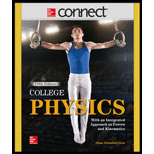
Concept explainers
The final speeds of the three rocks.
Answer to Problem 137P
The final speeds of the three rocks is
Explanation of Solution
Given that the initial speed of the rock is
Considering rock A, B, and C are dropped from same vertical height
From conservation of energy principle, energy associated with the rock A before dropping and after dropping are equal.
Here,
Rearrange the above equation to find
From conservation of energy principle, energy associated with the rock B before dropping and after dropping are equal.
Here,
Rearrange the above equation to find
From conservation of energy principle, energy associated with the rock C before dropping and after dropping are equal.
Here,
Rearrange the above equation to find
From equation (I), (II) and (III), it is clear the final velocity of the rock A, B, and C are equal
Conclusion:
Substitute
Since
Therefore, the final speeds of the three rocks is
Want to see more full solutions like this?
Chapter 6 Solutions
COLLEGE PHYSICS-CONNECT ACCESS
 College PhysicsPhysicsISBN:9781305952300Author:Raymond A. Serway, Chris VuillePublisher:Cengage Learning
College PhysicsPhysicsISBN:9781305952300Author:Raymond A. Serway, Chris VuillePublisher:Cengage Learning University Physics (14th Edition)PhysicsISBN:9780133969290Author:Hugh D. Young, Roger A. FreedmanPublisher:PEARSON
University Physics (14th Edition)PhysicsISBN:9780133969290Author:Hugh D. Young, Roger A. FreedmanPublisher:PEARSON Introduction To Quantum MechanicsPhysicsISBN:9781107189638Author:Griffiths, David J., Schroeter, Darrell F.Publisher:Cambridge University Press
Introduction To Quantum MechanicsPhysicsISBN:9781107189638Author:Griffiths, David J., Schroeter, Darrell F.Publisher:Cambridge University Press Physics for Scientists and EngineersPhysicsISBN:9781337553278Author:Raymond A. Serway, John W. JewettPublisher:Cengage Learning
Physics for Scientists and EngineersPhysicsISBN:9781337553278Author:Raymond A. Serway, John W. JewettPublisher:Cengage Learning Lecture- Tutorials for Introductory AstronomyPhysicsISBN:9780321820464Author:Edward E. Prather, Tim P. Slater, Jeff P. Adams, Gina BrissendenPublisher:Addison-Wesley
Lecture- Tutorials for Introductory AstronomyPhysicsISBN:9780321820464Author:Edward E. Prather, Tim P. Slater, Jeff P. Adams, Gina BrissendenPublisher:Addison-Wesley College Physics: A Strategic Approach (4th Editio...PhysicsISBN:9780134609034Author:Randall D. Knight (Professor Emeritus), Brian Jones, Stuart FieldPublisher:PEARSON
College Physics: A Strategic Approach (4th Editio...PhysicsISBN:9780134609034Author:Randall D. Knight (Professor Emeritus), Brian Jones, Stuart FieldPublisher:PEARSON





